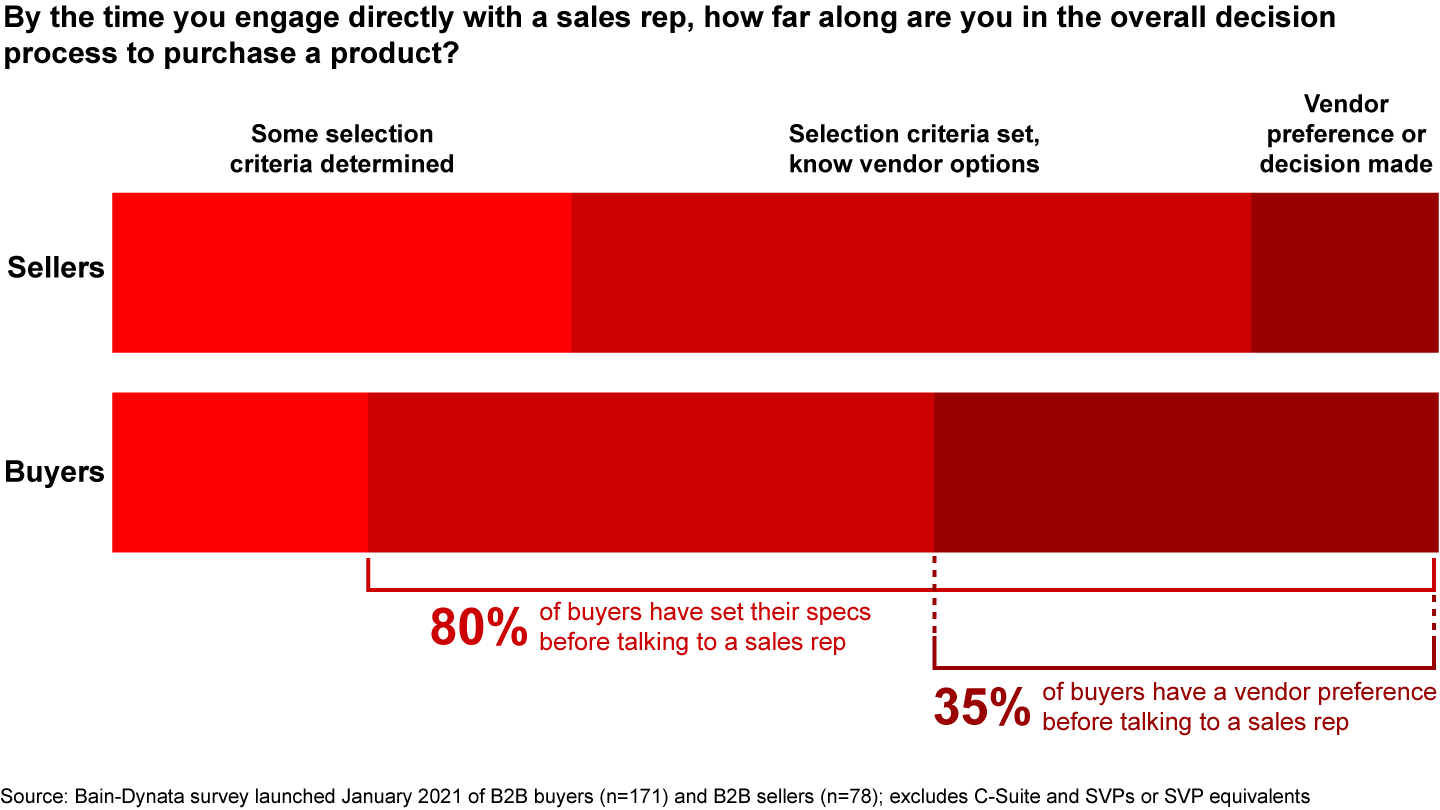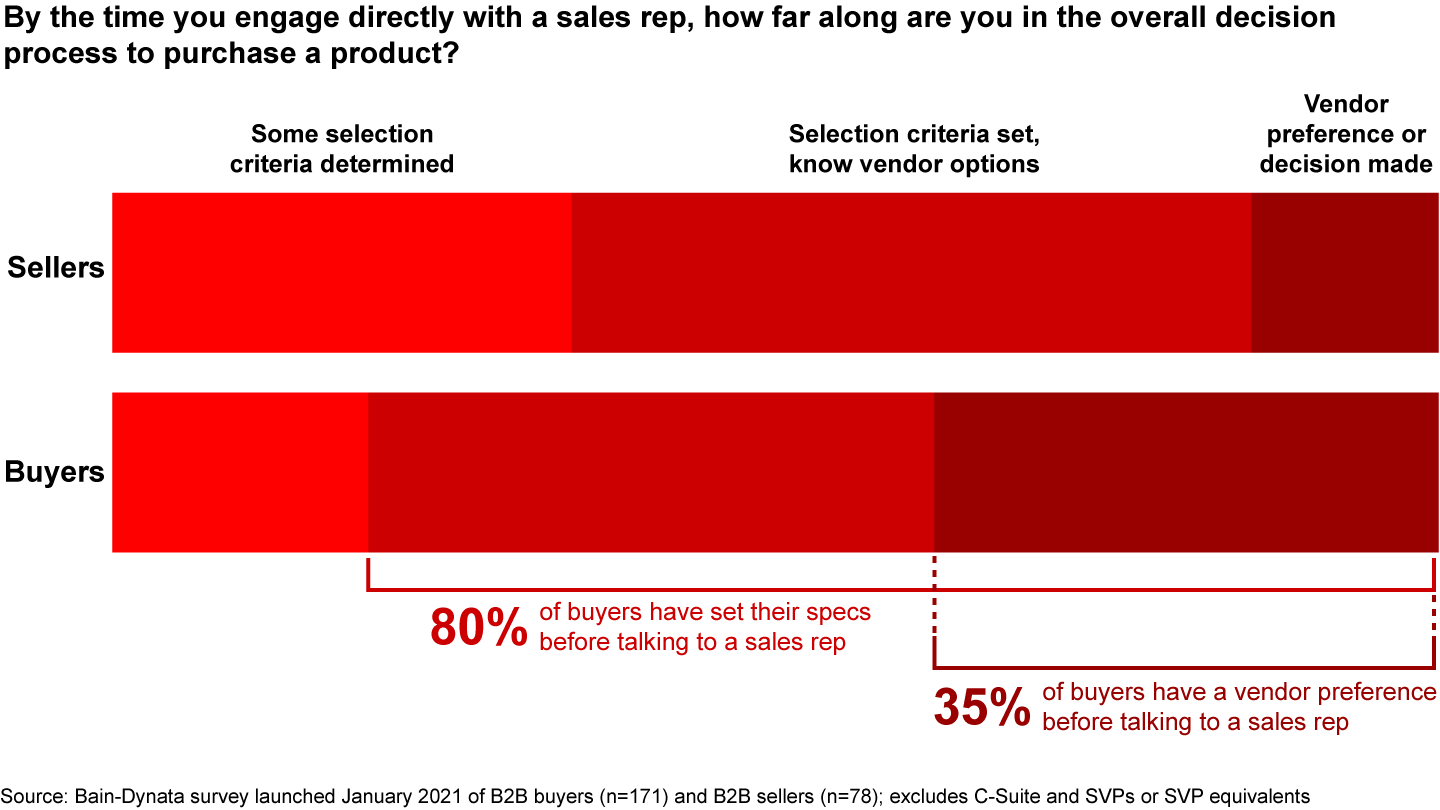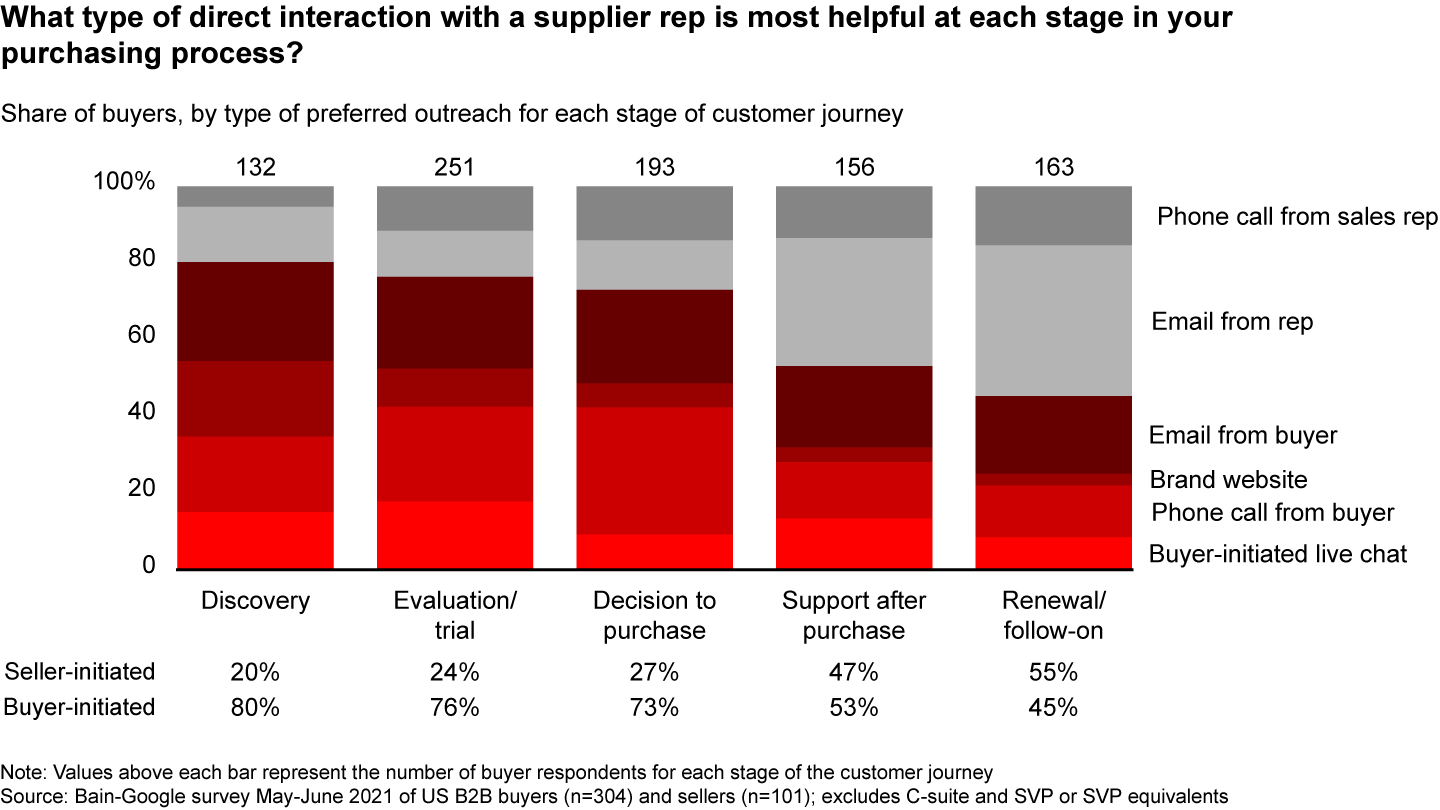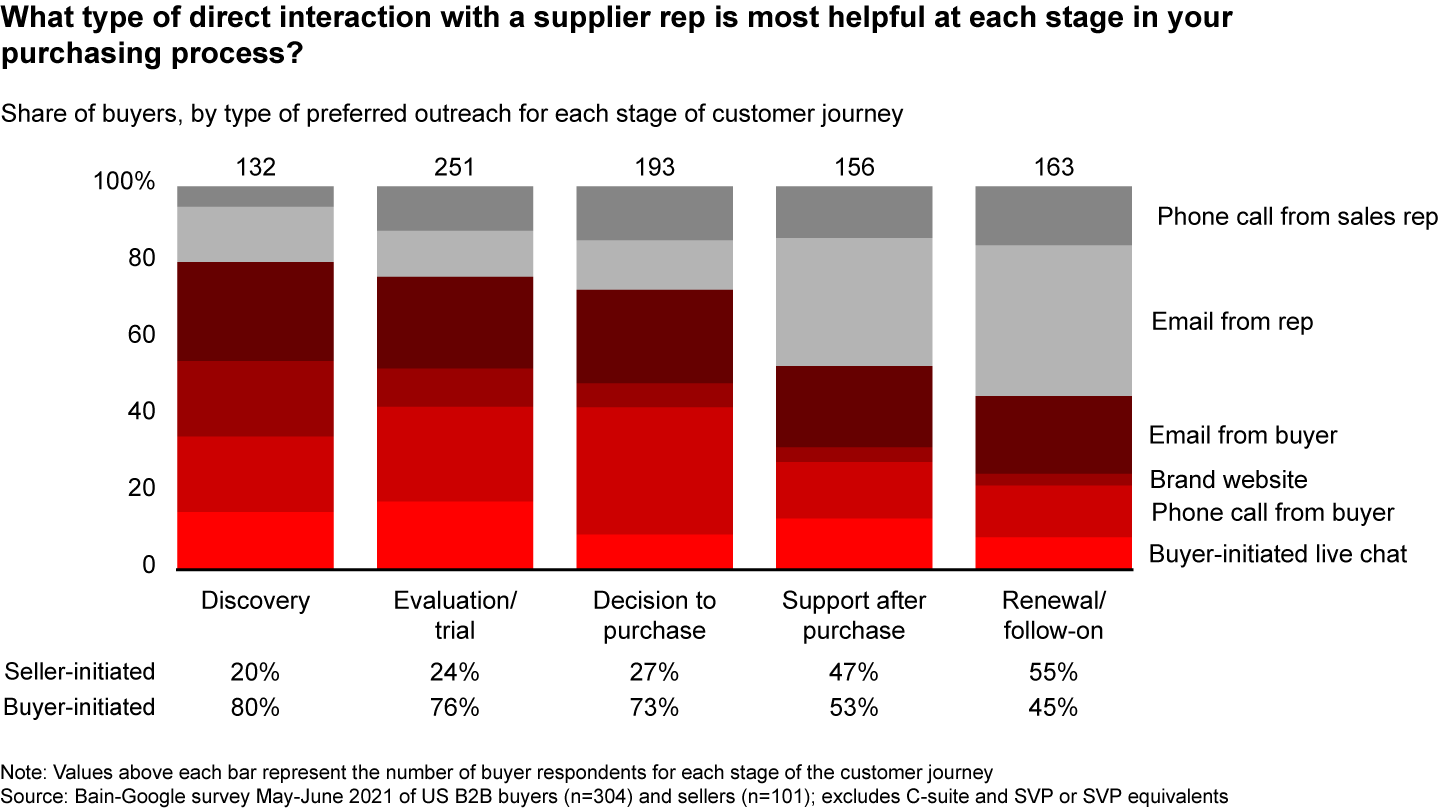Report

This article is part of Bain's 2021 Technology Report.
The past year highlighted an inconvenient truth about business-to-business sales that many executives have felt in their gut for a while: If a product’s digital presence doesn’t captivate a prospective buyer’s attention before a conversation with a sales representative, good luck making a sale.
What’s eye-opening is how much the Covid-19 pandemic has empowered buyers to do their digital homework on a product. Uncertain budgets and the lack of face-to-face sales meetings left buyers no choice, and they’ve found the digital discovery process to be effective and enjoyable. Now, vendor consideration depends significantly, and at times exclusively, on a product’s digital footprint.
Nevertheless, many sellers continue to underestimate the change. For both simple and complex, high-value purchases, around 35% of buyers already have a vendor preference before engaging with a sales rep, and 80% have solidified their decision criteria and vendor options, according to a survey conducted this year by Bain and Dynata (see Figure 1).


But it’s more than that. The salesforce is no longer the focal point of B2B selling. Marketing is playing a much bigger role in serving up offerings and generating demand. Often the product architecture needs to be rethought to enable prospective customers to engage with offerings online. And the growing importance of customer success has added another function that must be woven into the go-to-market model.
The most successful B2B technology providers recognize that changing buyer behavior demands rethinking and realigning their go-to-market model. Furthermore, they understand that the potential blurring of traditional and new go-to-market roles requires synchronizing functions and technology resources to orchestrate and support a constantly evolving―and ever more digital―customer journey.
Leading companies are focusing on three best practices.
1. Creating captivating experiences for buyers to digitally discover offerings
A majority of buyers indicate they prefer to contact a sales rep when they’re ready―not the other way around―at nearly every stage of the buying process and often through digital channels, according to a survey conducted this year by Bain and Google (see Figure 2). Early impressions matter.


Pouring money into search and basic digital marketing isn’t enough. Leading firms truly engage buyers digitally with a thoughtfully planned product experience that sparks interest and keeps them hooked, while clarifying how the product stands apart.
That requires a collaborative process between product managers and digital marketers to codesign the buyer’s product discovery journey. It’s also crucial to capture and analyze all of the digital exhaust that prospects leave behind. This informs which content―product demonstration videos, customer testimonials, self-assessment surveys, white papers―will best engage a prospective buyer.
One large enterprise software provider has recognized the power of personalized digital discovery. Tailoring messages to buyers’ specific challenges around remote work environments lifted its offerings’ share of impressions in search campaigns by 40%. Adding targeted educational messaging to email content improved click-to-open rates by up to five times.
2. Synchronizing all go-to-market functions
Salesforce productivity now depends upon seamless collaboration across functions to meet customers as they discover, try, transact, use, renew, and expand. Staying in sync across disparate go-to-market functions is now fundamental for delighting customers and growing share of wallet. That includes tight integration between marketing and sales on lead management, and between customer-success and account management after the sale and during the renewal cycle. Unfortunately, most companies’ go-to-market teams are a cacophony rather than a world-class symphony orchestra.
Leading companies are taking a two-pronged approach to synchronization.
First, they’re using sales plays as the “atomic unit” to connect strategy with execution and coordinate all the go-to-market functions. A sales play consists of a prescriptive, coordinated set of sales and marketing actions orchestrated to create and win a sales opportunity. An example in the technology sector is a competitive takeout play, where an attractive offer is targeted to displace a specific competitor’s offering.
Many technology providers say they run sales plays, but few execute them well. According to a recent survey conducted by Bain and Salesforce, winning B2B companies, defined by revenue and market share growth, are 2.7 times more likely to outperform on all the elements of an effective sales play system.
Executing a sales play requires a robust customer and prospect database that quantifies, for each buying unit within a company, the total available spend and share of spend by product category (what we call a MoneyMap℠). This helps prioritize sales plays and ensure marketing campaigns and sales resources are focused on the same plays, with the same messages, targeted toward the same prospective customers.
This isn’t just the domain of sales and marketing. For example, a provider of software-as-a-service pricing solutions for automotive dealers has a team of customer success managers monitoring each customer’s usage of its software. The customer success manager’s role is not to sell, but rather to help customers get the most value out of the software they’ve already purchased. The best customer success managers become deeply embedded, trusted advisers to customers, enabling them to provide valuable guidance on where the account team should be unearthing the next sales opportunity with the customer.
Second, they’re integrating workflows across the sales and marketing tech stack to support a seamless buying journey. About 60% of customer relationship management (CRM) deployments fail to meet return on investment (ROI) expectations, and a lack of tight integration with other relevant applications is often a root cause.
The winning B2B companies identified in our survey with Salesforce run on average more than 11 marketing and sales technology applications, while laggards run fewer than eight. Orchestrating them properly makes a big difference.
LeanData, a go-to-market solutions company, provides workflow optimization software that uses rules-based logic to help sync applications across its customers’ tech stacks, so they can deliver fast, accurate, and personalized outreach to their customers. Here’s a typical example. LeanData software makes it easier for users to prioritize, based upon the account status in Salesforce CRM, an inbound lead from Marketo initiated by a customer filling out a web form. It then allows users to quickly pull in contextual data provided by ZoomInfo to enrich the lead, route the lead to the right sales development representative or account executive, and then connect with a sales engagement platform like Outreach to deliver the right message. The prioritized, enriched lead crosses multiple applications in minutes instead of hours or days. This allows sales to contact the customer when their need is top of mind and prevents good leads from getting lost among technology platforms or in the hand off between marketing and sales.
3. Trading off investments across go-to-market functions
In any given year, go-to-market spending represents a technology vendor’s largest discretionary investments. However, companies tend to take a myopic view of spending, with each department jostling for its share of the budget. Moreover, it’s a real challenge to develop apples-to-apples ROI measures for investments spanning marketing, sales, and customer success. Even within a function, the highest ROI isn’t always clear. For example, the effectiveness of virtual selling during Covid-19 is prompting companies to reconsider their mix of virtual vs. traditional field sales capacity.
As a result, chief financial and revenue officers often struggle to decide where to invest their next dollar across go-to-market functions. This argues for more holistic and integrated planning for each function and role supporting key customer journeys. For companies with resources “rusted” in place, it’s time to start with a clean sheet.
Rather than aiming for the perfect theoretical approach, we suggest starting by benchmarking against competitors and identifying the breakthrough practices that address the following questions.
- What are the buyer personas and customer journeys that should guide my investments? Which go-to-market functions are critical to delivering these journeys?
- Should I invest in more sales capacity or spend more on marketing, with an expectation of higher sales productivity?
- How much should I invest in digital marketing? What low-ROI spending can I shift toward building a more captivating digital footprint?
- Which customer segments yield the greatest payoff from investing in customer success?
Macroeconomic disruptions dramatically reshape market positions, and the inventive disruptor can take significant share. With the rapid acceleration of buyers’ digital behaviors during Covid-19, is your organization ready to disrupt, or will it be disrupted?
Get Started with Sales Play System
Crack the code on sustained, profitable growth with Sales Play System. Start by taking our Maturity X-Ray, to get a quick, accurate read on your current sales performance.
MoneyMap® is a registered trademark of Bain & Company, Inc.